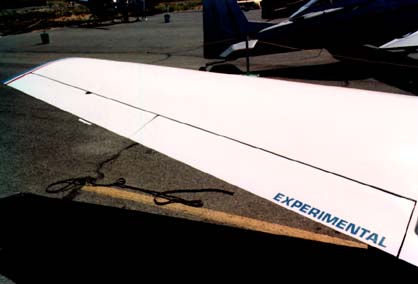Access Panels
![]()
Access Panels |
|
|
From "Construction Notes" Falco Builders Letter, June 1991 |
While George Barrett was here, I got a chance to wag my finger back in his face. George was starting to develop a bad case of access panel disease. He read somewhere that you have to rotate your pulleys are frequent intervals and wanted to put access panels for the Falco aileron cable pulleys. What is certainly true of a Cessna where the cables take 90° bends is not true of the Falco's aileron controls, where the cables only take a five-degree bend. You'll need to rotate the pulleys every 40 years or so.
And then he started looking at the flap torque tube and couldn't figure out how you've ever get the bolts out of the mounting plate if you wanted to remove the torque tube. Waitaminute George. Stop. It's very easy to rationalize yourself into all kinds of imagined needs for access panels. And before you know it, you will have a military airplane-a flying assemblage of access panels. Keep this kind of thinking going, and you'll turn the wonderfully integral structure of the Falco into Swiss cheese. Don't do it.
It's far better to install the absolute minimum number of access panels that we show on the drawings, then fifty years from now when someone wants to replace the aileron cables and rotate the pulleys, let them cut a hole and repair the skin when they're through-assuming they're still growing trees at that time. Simply put, there are parts of the Falco that you have to get at with such phenomenally long intervals that it's far better to not provide an access panel at all. Syd Jensen even omitted the slot in the bottom of the wing to permit you to remove the landing gear-not all that crazy a move since most Falcos never have the gear out.
|
From "Construction Notes" Falco Builders Letter, September 1994 |

Rex Hume: "After considerable discussion at the West Coast Falco Fly-In that cutouts and access doors are not necessary on the top of the wing-keep it clean."
|
From "Construction Notes" Falco Builders Letter, December 1987 |
Our wing drawings show a nifty way of installing the access panels using aluminum inserts and machine screws. Jim DeAngelo was the first to do this type of thing, but he used Rivnuts epoxied in the spruce. This has the advantage of nice, reusable metal threads in the wood.
I liked the general idea, but the outside of a Rivnut is smooth, there's a shoulder on the face, and it requires an installation tool. There must be a better way. One day I found exactly what I was looking for, an insert made for the injection-molded plastics industry. The little aluminum insert had a coarse diamond knurl and a blind end, so you could epoxy it in place and not worry about epoxy getting in the threads from the far end. They were cheap and available in quantity. So I drew them on the new wing drawings-see Drawing No. 201, Detail J.
Then I lost the product literature and couldn't remember who made the silly thing. Recently, I found the name of the company again, and we quickly bought a supply. I think that once you use a couple of these, you are going to start putting them everywhere. Rather than sprinkling these among the various kits in the quantity needed, we have put together a bag of 50 of the P/N 837-17 inserts and the required 6-32 machine screws-that's enough for an entire airplane, I hope-and added these to the tail group kits. If you would like these little things, it's $10.00 for 50 inserts and 50 screws, so just request it with your next order or Brenda Avery fan letter.
|
|